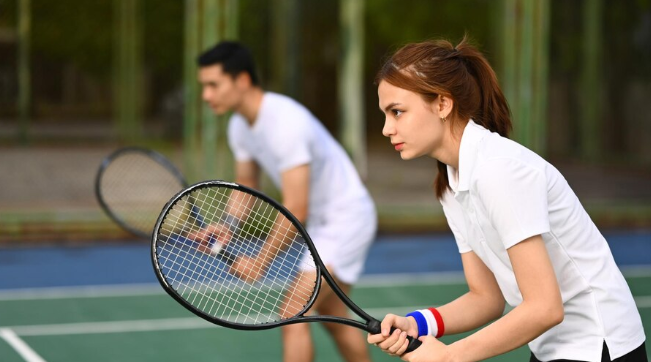Differences Between Singles and Doubles Tennis Strategies:An Ultimate Guide

As an avid tennis player, I have come to appreciate the nuanced differences between singles and doubles strategies on the court. While both formats require skill, endurance, and a keen understanding of the game, the tactics employed in each can vary significantly. In this comprehensive guide, we will delve into the intricacies of singles and doubles tennis strategies, exploring the unique challenges and approaches that define each format.
Understanding Singles Tennis
Singles tennis is a one-on-one battle, where players rely solely on their individual prowess to outmaneuver their opponent. In this section, we will uncover the key strategies that can elevate your singles game.
Key Strategies for Singles Tennis
Consistency and Patience: In singles tennis, consistency is paramount. Every shot counts, and maintaining a steady baseline game is crucial. Patience is also a virtue, as wearing down your opponent and capitalizing on their errors can often be the path to victory.
Court Coverage: With no partner to rely on, court coverage becomes an essential aspect of singles play. Anticipating your opponent's shots and positioning yourself accordingly can mean the difference between winning and losing a point.
Tactical Shot Selection: Singles tennis allows for a wider range of shot selection, from powerful groundstrokes to delicate drop shots. Mastering a variety of shots and employing them strategically can keep your opponent guessing and off-balance.
Understanding Doubles Tennis
Doubles tennis introduces a new dynamic, where teamwork and communication become essential elements of success. In this section, we will explore the key strategies that can elevate your doubles game.
Key Strategies for Doubles Tennis
Formation and Court Positioning: In doubles, proper court positioning and formation are crucial. Understanding the roles of the server, server's partner, and the returners can significantly impact your team's ability to control the court and create offensive opportunities.
Communication and Teamwork: Effective communication between partners is vital in doubles tennis. Calling out shots, coordinating movements, and supporting each other's strategies can create a formidable team dynamic.
Poaching and Offensive Tactics: Doubles tennis often revolves around aggressive net play and poaching opportunities. Identifying the right moments to poach and execute offensive tactics can put immense pressure on your opponents and potentially end points quickly.
Communication and Teamwork in Doubles
Successful doubles partnerships rely heavily on effective communication and teamwork. Establishing clear lines of communication, both verbal and non-verbal, can enhance your team's ability to anticipate each other's movements and make split-second decisions on the court.
Moreover, fostering a strong team dynamic and mutual trust is essential. Supporting your partner's strengths, covering their weaknesses, and celebrating victories together can create a cohesive unit that thrives under pressure.
Court Positioning and Movement
In both singles and doubles tennis, court positioning and movement play a crucial role in dictating the flow of the game. However, the strategies employed in each format can differ significantly.
In singles tennis, court positioning is often centered around controlling the baseline and anticipating your opponent's shots. Efficient footwork and lateral movement become essential for covering the court effectively.
On the other hand, in doubles tennis, court positioning revolves around formations and strategic positioning based on the server's and returner's roles. Coordinated movements and split-step techniques are vital for seamless transitions and quick reaction times.
Serving Strategies in Singles vs. Doubles
The serve is a fundamental aspect of tennis, and the strategies employed in singles and doubles can vary substantially.
In singles tennis, the serve is often used as an offensive weapon, with players aiming for power, spin, and placement to put immediate pressure on their opponent. Mixing up serve locations, speeds, and spins can keep the returner off-balance and create offensive opportunities.
In doubles tennis, the serving strategy takes on a different dimension. While power and placement are still important, the focus shifts towards setting up offensive opportunities for the server's partner. Serving to specific court locations and employing spin variations can create poaching opportunities and put the returning team on the defensive.
Return of Serve Tactics
Returning serve is a critical aspect of both singles and doubles tennis, and the tactics employed can significantly impact the outcome of a point.
In singles tennis, returning serve is often a defensive play, with players aiming to get the ball back in play and establish control of the baseline. Employing a consistent return and neutralizing the server's power can set the stage for offensive opportunities later in the point.
In doubles tennis, return of serve tactics become more intricate. Players must not only focus on getting the ball back in play but also consider positioning and creating offensive opportunities for their partner. Effective communication and shot selection during the return can set the tone for aggressive net play and potential poaching situations.
Net Play: Singles vs. Doubles
Net play is a crucial aspect of both singles and doubles tennis, but the strategies and techniques employed can differ significantly.
In singles tennis, net play is often a tactical choice, with players approaching the net to finish points or apply pressure on their opponent. Effective net play requires precise volleys, anticipation, and the ability to transition seamlessly from baseline to net.
In doubles tennis, net play is a fundamental component of the game. Players must master the art of poaching, executing sharp volleys, and covering the court effectively as a team. Effective net play in doubles often revolves around aggressive positioning, anticipation, and communication with your partner.
Common Mistakes in Singles and Doubles Strategies
While mastering tennis strategies is a continuous journey, there are certain common mistakes that players should be aware of and strive to avoid.
In singles tennis, some common mistakes include:
Overplaying and attempting low-percentage shots
Failing to construct points effectively
Neglecting court positioning and movement
In doubles tennis, common mistakes may include:
Lack of communication and coordination with your partner
Incorrect court positioning and formation
Missed poaching opportunities or poor net play
Recognizing and addressing these mistakes can help players improve their overall strategies and achieve greater success on the court.
How to Transition Between Singles and Doubles Play
For many players, transitioning between singles and doubles play can be a challenging task. The mindset, tactics, and court positioning required in each format can vary greatly, and adapting to these differences is crucial for success.
When transitioning from singles to doubles, players must shift their focus to effective communication, teamwork, and court positioning. Embracing the roles and responsibilities of a doubles partnership and adjusting shot selection accordingly can facilitate a smoother transition.
Conversely, when transitioning from doubles to singles, players must recalibrate their mindset to a more individualistic approach. Developing a consistent baseline game, improving court coverage, and mastering a wider range of shot selection become essential.
Incorporating specific training drills and practice sessions that mimic the demands of each format can greatly aid in this transition process.
Training Drills for Singles and Doubles
To further enhance your skills and strategies in both singles and doubles tennis, incorporating targeted training drills into your practice routine can be highly beneficial.
For singles tennis, drills focused on consistency, court coverage, and shot variety can be invaluable. Examples include:
Crosscourt groundstroke drills
Defensive footwork and movement patterns
Serve and return of serve practice
For doubles tennis, drills that emphasize communication, teamwork, and net play can be particularly effective. Some examples include:
Poaching and transition drills
Situational doubles scenarios
Serve and return formations
Regularly incorporating these drills into your training regimen can help ingrain the specific strategies and techniques required for success in both singles and doubles tennis.
Case Studies: Successful Singles and Doubles Players
To better understand the application of singles and doubles strategies, let's examine the careers of some of the most successful players in each format.
In singles tennis, players like Roger Federer and Serena Williams have exemplified the art of consistent baseline play, tactical shot selection, and court coverage. Their ability to construct points and capitalize on opportunities has made them legends of the game.
On the doubles front, teams like the Bryan Brothers (Bob and Mike) and the Williams Sisters (Venus and Serena) have showcased the power of effective communication, teamwork, and aggressive net play. Their ability to anticipate each other's movements and execute seamless strategies has led to numerous Grand Slam titles and a lasting legacy in doubles tennis.
By studying the strategies and techniques employed by these successful players, we can gain valuable insights and apply them to our own games, whether in singles or doubles formats.
Conclusion: Mastering Both Singles and Doubles Tennis Strategies
Mastering both singles and doubles tennis strategies is a challenge that requires dedication, practice, and a deep understanding of the game's nuances. While the tactics and approaches may differ, the fundamental principles of consistency, court positioning, and shot selection remain constant.
By embracing the unique challenges of each format and continuously refining our skills, we can elevate our overall tennis game and enjoy the thrill of competition on the court. Whether you're a singles specialist or a doubles dynamo, the pursuit of mastery in both formats can lead to a more well-rounded and rewarding tennis experience.
If you're ready to take your tennis game to the next level, consider signing up for personalized coaching or joining a local tennis academy. With expert guidance and tailored training programs, you can unlock your full potential and master the art of singles and doubles tennis strategies.
